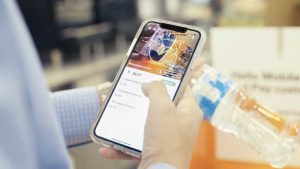Consumers shopping at 14 7-Eleven Inc. stores in the Dallas area can test the convenience-store chain’s new Scan & Pay feature to make purchases without stopping at the checkout counter, 7-Eleven announced Monday.
The service, part of the 7-Eleven app that also houses the 7Rewards loyalty feature, enables consumers to avoid long checkout lines, 7-Eleven says in a press release. Scan & Pay is available for iOS and Android devices and can pay for all 7-Eleven merchandise except items requiring cashier help, such as hot food, alcohol and tobacco, and lottery tickets.
7-Eleven says consumers can use Apple Pay, Google Pay, or a credit card or debit card to pay for items. Purchased items are placed in clear shopping bags. Users also must be in or around one of the 14 test stores for the shopping feature to appear in the app.
Upon completing their shopping, users scan a quick-response code displayed on the final confirmation screen at a Scan & Pay station.

“Customers can now take control of their shopping experience and earn loyalty points at the same time,” Gurmeet Singh, 7-Eleven chief digital officer and chief information officer, says in a press release. “Customers are given a variety of options when they walk into a 7-Eleven store, from product assortment and customization all the way to payment methods. We are taking the in-store retail experience to the next level with a series of innovations. Scan & Pay is one of them.”
7-Eleven says it plans to expand the availability of the proprietary payment technology to more cities in 2019.
Scan & Pay, because it’s coupled to the c-store chain’s loyalty program within one app, is another example of how retailers “increasingly view their app as a platform where they can intertwine payment, rewards, loyalty, and engagement into a tightly integrated and controlled experience,” says Jordan McKee, research director at New York City-based 451 Research.
That tight integration likely will be most valuable to a minority of shoppers. “It’s unrealistic to think that every shopper will use a retailer’s app,” McKee says. “According to 451 Research’s October 2018 Voice of the Connected User Landscape Survey, of more than 2,800 consumer surveyed, only 2.4% would prefer to pay by using a separate app for each retailer they shop with. Retail-branded apps will only see adoption by frequent shoppers that have a pre-existing affinity for shopping with that specific retailer.”
Still, the effort to produce an app with multiple features could be worthwhile.
“Convenience is a top vertical for implementing a ‘grab and go’ payment experience thanks to the frequency of purchase, small basket sizes, and limited inventory,” McKee tells Digital Transactions News in an email. “7-Eleven’s move toward this type of shopping experience is a clear indicator that it sees Amazon Go as a long-term competitive threat.”
Amazon.com Inc. this year opened the first of its Amazon Go convenience stores outside of Seattle with plans to add more.
Retailers miss out on a lot of sales—$37.7 billion in the past year according to 451 Research—because of shoppers abandoning long lines, McKee says. “A ‘grab and go’ payment experience is positioned as an attractive way to help retailers in certain verticals reclaim these missed revenue opportunities.”





